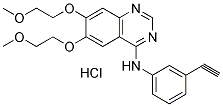All AbMole products are for research use only, cannot be used for human consumption.

Erlotinib Hydrochloride also known as Tarceva, CP-358774, OSI-774 and NSC-718781, is an inhibitor of human EGFR tyrosine kinase (IC50 = 2 nM) and decreases EGFR autophosphorylation in tumor cells (IC50 = 20 nM). Erlotinib specifically targets the epidermal growth factor receptor (EGFR) tyrosine kinase, which is highly expressed and occasionally mutated in various forms of cancer. It binds in a reversible fashion to the adenosine triphosphate (ATP) binding site of the receptor.
| Cell Experiment | |
|---|---|
| Cell lines | BxPC-3 and MIAPaCa cells |
| Preparation method | Cell Viability Assay To test the viability of cells treated with B-DIM, erlotinib, or the combination, BxPC-3 and MIAPaCa cells were plated (3,000-5,000 per well) in a 96-well plate and incubated overnight at 37jC. We initially tested a range of concentrations for both B-DIM (10-50 µmol/L) and erlotinib (1-5 µmol/L). Based on the initial results, the concentration of B-DIM (20 Amol/L) and erlotinib (2 Amol/L) were chosen for all assays. The effects of B-DIM (20 µmol/L), erlotinib (2 µmol/L), and the combination on BxPC-3 and MIAPaCa cells were determined by the standard 3-(4,5- dimethylthiazol-2-yl)-2,5-diphenyltetrazolium bromide (MTT) assay after 72 h and was repeated three times. The color intensity was measured by a Tecan microplate fluorometer at 595 nm. DMSO-treated cells were considered to be the untreated control and assigned a value of 100%. |
| Concentrations | 1-5 µmol/L |
| Incubation time | 72 h |
| Animal Experiment | |
|---|---|
| Animal models | SCID mice bearing orthotopically implanted BxPC-3 pancreatic tumor cells |
| Formulation | not mentioned |
| Dosages | 50 mg/kg body weight every day for 15 days |
| Administration | i.p. |
| Molecular Weight | 429.90 |
| Formula | C22H23N3O4.HCl |
| CAS Number | 183319-69-9 |
| Solubility (25°C) | DMSO 3 mg/mL |
| Storage |
Powder -20°C 3 years ; 4°C 2 years In solvent -80°C 6 months ; -20°C 1 month |
| Related EGFR/HER2 Products |
|---|
| Depatuxizumab
Depatuxizumab is a brain-penetrant and humanized tumor-specific anti EGFR monoclonal antibody. Depatuxizumab inhibits the growth of xenograft models of mutant EGFRvIII and wild-type EGFR. |
| Sevabertinib
Sevabertinib is an epidermal growth factor receptor (EGFR) tyrosine kinase inhibitor with antitumor activity. |
| BPIQ-I
BPIQ-I (PD 159121) is a potent and ATP-competitive EGFR tyrosine kinase inhibitor.. |
| HKI-357
HKI-357 is an irreversible dual inhibitor of EGFR and ERBB2 with IC50s of 34 nM and 33 nM, respectively. |
| SJF-1528
SJF-1528 is a potent EGFR PROTAC degrader with DC50 values of 39.2 nM and 736.2 nM for wild-type EGFR in OVCAR8 cells and Exon 20 Ins mutated EGFR in HeLa cells. |
All AbMole products are for research use only, cannot be used for human consumption or veterinary use. We do not provide products or services to individuals. Please comply with the intended use and do not use AbMole products for any other purpose.


Products are for research use only. Not for human use. We do not sell to patients.
© Copyright 2010-2024 AbMole BioScience. All Rights Reserved.
